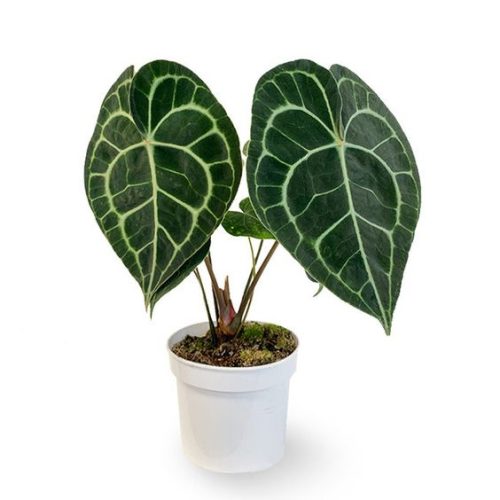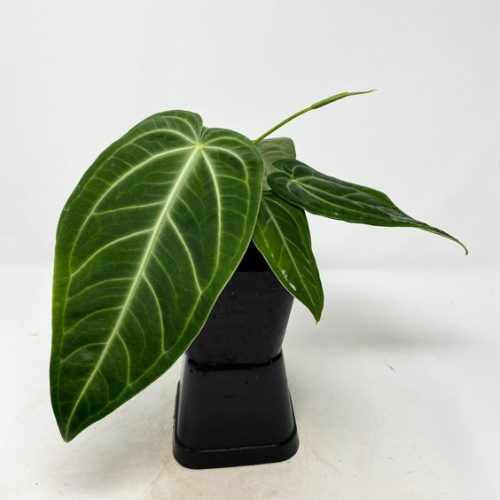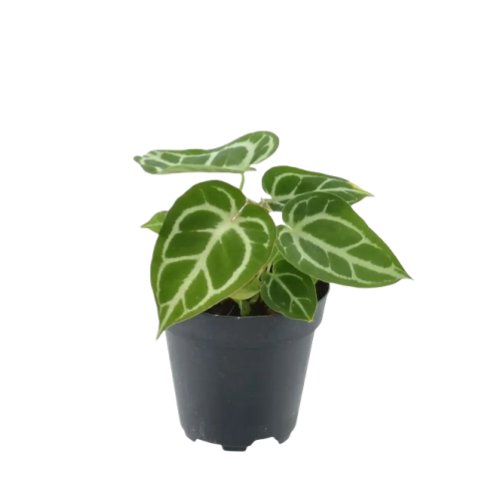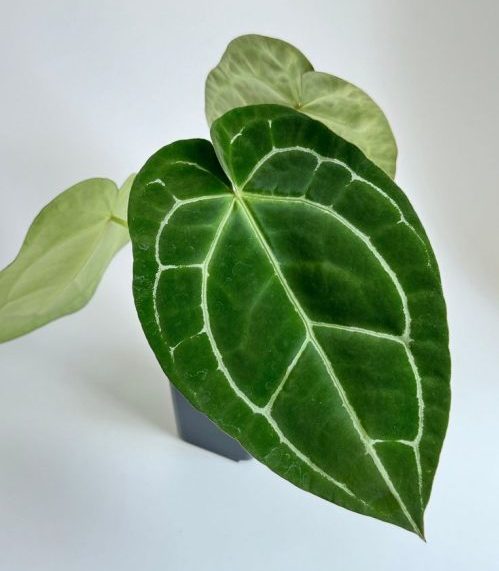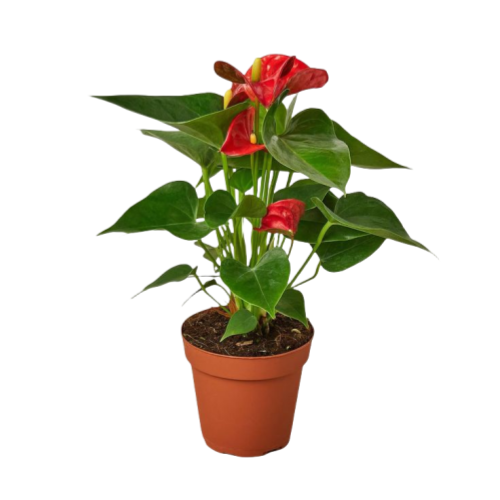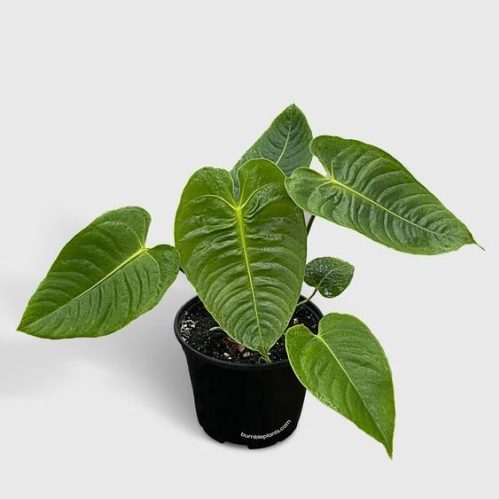Anthurium Superbum
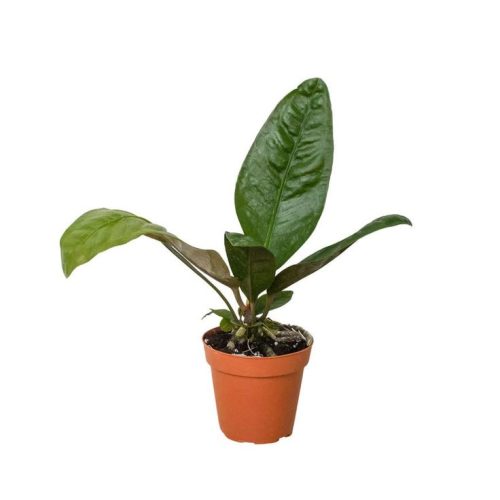
- Botanical Name: Anthurium Superbum Madison
- Family Name: Araceae
- Stems: 3-5 inches
- Temperature: 18℃-24℃
- Other: warmth, indirect light, and humidity
Overview
Product Description
Jungle Roots: How the Anthurium Superbum Found Its Perch
Ecuadorian Enchanter: The Arboreal Origins of Anthurium Superbum
Anthurium Superbum, also known as the Bird’s Nest Anthurium, claims the misty lowland forests of Ecuador as its native home. This tropical fern ally flourishes at moderate elevations, typically between 650 to 1,150 feet (200 to 350 meters), where the air is thick with moisture and the undergrowth is lush with life. In these forests, the Anthurium Superbum has evolved to become a master of aerial living, an epiphyte that dances gracefully among the branches.
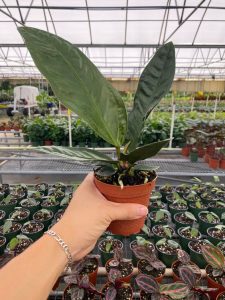
Anthurium Superbum
As an epiphyte, Anthurium Superbum has a rather unconventional growth habit. It forages the bark of other trees, using its aerial roots not to delve into soil but to latch onto the trunks and branches of its forest neighbors. These roots, often pink and robust, are equipped with the ability to absorb nutrients not only from the decaying matter around them but also directly from the air.
The plant’s unique ability to grow without soil makes it a botanical wonder, showcasing nature’s ingenuity in the diverse ways plants can thrive. In its natural habitat, Anthurium Superbum’s rosette of stiff, leathery leaves forms a bowl-like structure that collects rainwater and debris. This natural basin not only provides a reservoir for the plant during the dry spells but also creates a miniature ecosystem that supports a variety of forest critters.
The Anthurium Superbum’s adaptation to its forest ecosystem is a testament to its resilience and versatility. It stands as a silent sentinel in the Ecuadorian lowlands, its leaves reaching out to form a protective nest that invites life to flourish within its embrace. This plant is not just a passive observer in its environment but an active participant, shaping its own survival story in the eternal ballet of the rainforest.
Leafy Labyrinth: The Quirky Contours of Our Feathery Friend
This plant is known for its long, stiff leaves that fan out to form a bowl shape, resembling a bird’s nest, hence its nickname. The leaves are elliptical to oblong-elliptic, with a dark purple-green color on the front and occasionally purple or red on the back. The plant’s inflorescence is erect and shorter than the leaf, with a white spadix that turns rose, and a green spathe. It bears purple berries。
Humidity Hut or Arid Abode: Where This Plant Calls Home
Anthurium Superbum thrives in high humidity and moderate temperatures. It prefers bright indirect light but can tolerate lower light conditions. The plant is not particular about humidity and can manage with average home humidity levels, although it appreciates higher humidity which can encourage larger leaf growth。
Green Envy: The Anthurium Superbum’s Secret Celebrity Status
Ecuadorian Enchanter: The Arboreal Origins of Anthurium Superbum
Anthurium Superbum, also known as the Bird’s Nest Anthurium, claims the misty lowland forests of Ecuador as its native home. This tropical fern ally flourishes at moderate elevations, typically between 650 to 1,150 feet (200 to 350 meters), where the air is thick with moisture and the undergrowth is lush with life. In these forests, the Anthurium Superbum has evolved to become a master of aerial living, an epiphyte that dances gracefully among the branches.
As an epiphyte, Anthurium Superbum has a rather unconventional growth habit. It forages the bark of other trees, using its aerial roots not to delve into soil but to latch onto the trunks and branches of its forest neighbors. These roots, often pink and robust, are equipped with the ability to absorb nutrients not only from the decaying matter around them but also directly from the air.
The plant’s unique ability to grow without soil makes it a botanical wonder, showcasing nature’s ingenuity in the diverse ways plants can thrive. In its natural habitat, Anthurium Superbum’s rosette of stiff, leathery leaves forms a bowl-like structure that collects rainwater and debris. This natural basin not only provides a reservoir for the plant during the dry spells but also creates a miniature ecosystem that supports a variety of forest critters.
The Anthurium Superbum’s adaptation to its forest ecosystem is a testament to its resilience and versatility. It stands as a silent sentinel in the Ecuadorian lowlands, its leaves reaching out to form a protective nest that invites life to flourish within its embrace. This plant is not just a passive observer in its environment but an active participant, shaping its own survival story in the eternal ballet of the rainforest.
Window Wonder or Bath Buddy: Perfect Spots for Your New Plant Pal
This plant is suitable for indoor settings, especially near north or east-facing windows where it can receive plenty of indirect light. It can also be placed in bathrooms or other humid areas of the home. Outdoors, it can be grown in USDA hardiness zones 10a and 11, provided it has protection from direct sunlight and cold drafts。
Thirsty? Not Really: The Lazy Gardener’s Guide to Watering Wisdom
One of the unique aspects of Anthurium Superbum is its ability to tolerate lower humidity and less frequent watering due to its thick leaves and robust roots. It also has a slow growth rate, which makes it a low-maintenance addition to any garden. The plant’s air-purifying properties and its tolerance to a range of conditions make it an excellent choice for those seeking a hardy, visually impressive houseplant。





